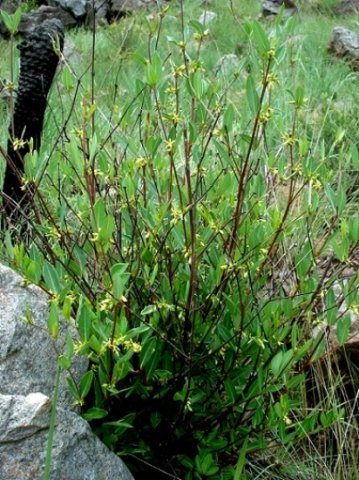Cryptolepis oblongifolia, better known as bokhorings

Author: Ivan Lätti
Photographer: Judd Kirkel Welwitch
Cryptolepis oblongifolia, known as the red-stemmed cryptolepis and in Afrikaans as bokhorings (antelope horns), is a multi-stemmed shrub that grows to 1 m in height and tends to scramble. One of its older scientific names was Cryptolepis scandens, referring to this climbing tendency.
Another of the more than 30 earlier appellations conferred upon the plant by scientists in the past is C. suffruticosa, indicating that it grows from a substantial woody rootstock. The suffrutex allows for resprouting after grass fires. This woody underground part usually survives a fire, assisted by the juxtaposed rock, so often seen next to a well established plant.
The photo shows the rocky abode of this flourishing plant in its summer milieu. In winter all around it will be dry and grey, fire never far from the minds of those that care for the veld. Resprouting plants have head-start after fire, showing vigorous green growth among the grass within days of the first temperature rise announcing spring.
The converse adjustment is found in reseeder plants that have to start all over again from baby plant beginnings. Maturity and being ready for full functioning come to some of them only after some years. Rearranging the seniority of leafy citizens from time to time in an ecological system enhances diversity: Species succeed each other cyclically for a few seasons on the same land, taking turns to be dominant.
This speeds up the return of life support for all the animals, birds and insects on the land, restoring food and shelter in the complex matrix of interdependencies. Erosion of the soil may also be less, due to the quick return of binding from strong root systems (Van Wyk and Malan, 1997).
(More photos of this plant are shown in the Shrubs Album under Types.)

